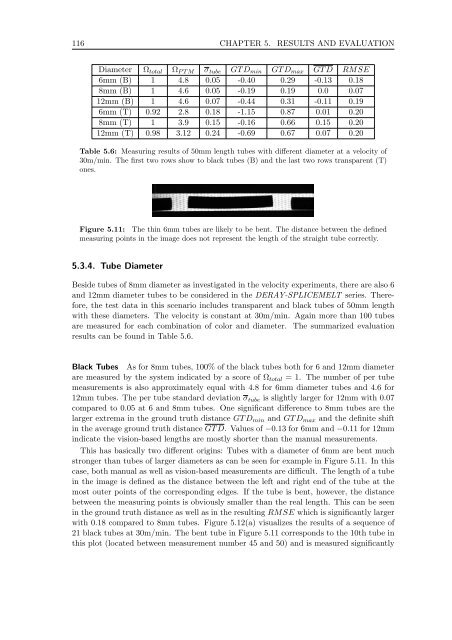Master Thesis - Fachbereich Informatik
Master Thesis - Fachbereich Informatik
Master Thesis - Fachbereich Informatik
Create successful ePaper yourself
Turn your PDF publications into a flip-book with our unique Google optimized e-Paper software.
116 CHAPTER 5. RESULTS AND EVALUATION<br />
Diameter Ωtotal ΩPTM σtube GT Dmin GT Dmax GT D RMSE<br />
6mm (B) 1 4.8 0.05 -0.40 0.29 -0.13 0.18<br />
8mm (B) 1 4.6 0.05 -0.19 0.19 0.0 0.07<br />
12mm (B) 1 4.6 0.07 -0.44 0.31 -0.11 0.19<br />
6mm (T) 0.92 2.8 0.18 -1.15 0.87 0.01 0.20<br />
8mm (T) 1 3.9 0.15 -0.16 0.66 0.15 0.20<br />
12mm (T) 0.98 3.12 0.24 -0.69 0.67 0.07 0.20<br />
Table 5.6: Measuring results of 50mm length tubes with different diameter at a velocity of<br />
30m/min. The first two rows show to black tubes (B) and the last two rows transparent (T)<br />
ones.<br />
Figure 5.11: The thin 6mm tubes are likely to be bent. The distance between the defined<br />
measuring points in the image does not represent the length of the straight tube correctly.<br />
5.3.4. Tube Diameter<br />
Beside tubes of 8mm diameter as investigated in the velocity experiments, there are also 6<br />
and 12mm diameter tubes to be considered in the DERAY-SPLICEMELT series. Therefore,<br />
the test data in this scenario includes transparent and black tubes of 50mm length<br />
with these diameters. The velocity is constant at 30m/min. Again more than 100 tubes<br />
are measured for each combination of color and diameter. The summarized evaluation<br />
results can be found in Table 5.6.<br />
Black Tubes As for 8mm tubes, 100% of the black tubes both for 6 and 12mm diameter<br />
are measured by the system indicated by a score of Ωtotal = 1. The number of per tube<br />
measurements is also approximately equal with 4.8 for 6mm diameter tubes and 4.6 for<br />
12mm tubes. The per tube standard deviation σtube is slightly larger for 12mm with 0.07<br />
compared to 0.05 at 6 and 8mm tubes. One significant difference to 8mm tubes are the<br />
larger extrema in the ground truth distance GT Dmin and GT Dmax and the definite shift<br />
in the average ground truth distance GT D. Values of −0.13 for 6mm and −0.11 for 12mm<br />
indicate the vision-based lengths are mostly shorter than the manual measurements.<br />
This has basically two different origins: Tubes with a diameter of 6mm are bent much<br />
stronger than tubes of larger diameters as can be seen for example in Figure 5.11. In this<br />
case,bothmanualaswellasvision-basedmeasurementsaredifficult. Thelengthofatube<br />
intheimageisdefinedasthedistancebetweentheleftandrightendofthetubeatthe<br />
most outer points of the corresponding edges. If the tube is bent, however, the distance<br />
between the measuring points is obviously smaller than the real length. This can be seen<br />
in the ground truth distance as well as in the resulting RMSE which is significantly larger<br />
with 0.18 compared to 8mm tubes. Figure 5.12(a) visualizes the results of a sequence of<br />
21 black tubes at 30m/min. The bent tube in Figure 5.11 corresponds to the 10th tube in<br />
this plot (located between measurement number 45 and 50) and is measured significantly














